The seller didn't include much detail for this photo, so we'll have to make do with a bit of guesswork. If you can add anything to the story, please let us know in the comments below.
Who: Certainly not a bunch of tourists, they're several of the ship's crew, having their photo taken as they visit Hong Kong. There's quite a range of ages, the three oldest men in the centre of the photo, and much younger men around them.
Most of them are wearing very grey and grubby-looking clothes. Are they the stokers, covered with coal dust from shovelling coal into the ship's boilers?
With all that grey, the chinese man stands out in his white cook's jacket:
He's also the only one with a smile - happy to be back home to Hong Kong after a long trip overseas? I bought this photo from a seller in the USA, suggesting that's where the ship and its crew operated from.
The other man in a clean shirt is the one on the right:
He's different in other ways too:
A comparison with the man standing next to him shows he's got much cleaner hands. He's the only one in the group with polished shoes, and it looks as though he's holding a pencil. Maybe he's from a senior part of the crew? Then what about the frayed ends to his trousers? Are they just his working clothes, or is he short of money - or both?
When: I'll guess the first quarter of the twentieth century, but if you can see any clues from their clothing or the surroundings, please let us know. Here's the back of the postcard, which unfortunately shows us almost nothing:
You can see the photo has been ripped from a photo album. Also that this was sold as a postcard, made by sticking a photograph on the front of a pre-printed card. That's different from the other photo-postcards we've seen, where the photo was developed on special photographic paper, already pre-printed with postcard markings. For that reason I'll guess this comes from nearer to 1900 than 1925.
Where: There's a sea wall in the background, but the ship isn't tied up against it. Instead I think the ship is tied up to a pier at right-angles to the main sea wall. That suggests Kowloon Wharves. Can anyone recognise the buildings in the background?
What: From the curve of the deck, I guess we're looking at the stern of the ship. From their height, it looks to be a large ship too. Hopefully some of the shipping experts reading this can spot other clues about what we're looking at.
Regards, David
PS A couple of dates for your diary:
- London: Next Tuesday, 17th Jan I'll be in London, and will meet with a few Gwulo readers for lunch. Come along and join us if you're free. Click for details.
- Hong Kong: This Saturday, 14th Jan there's a guided walk around Hong Kong Cemetery with all proceeds to charity. Click for details.
Reference: A095
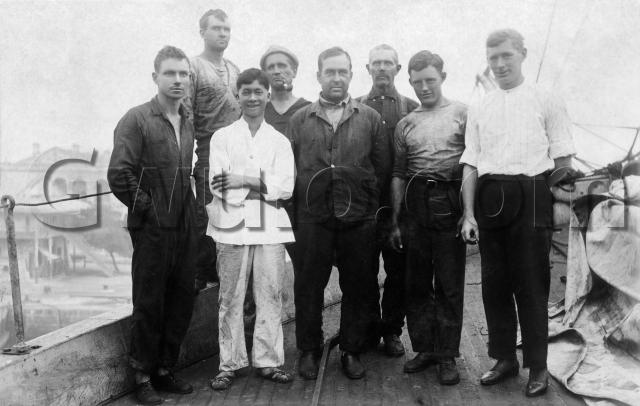
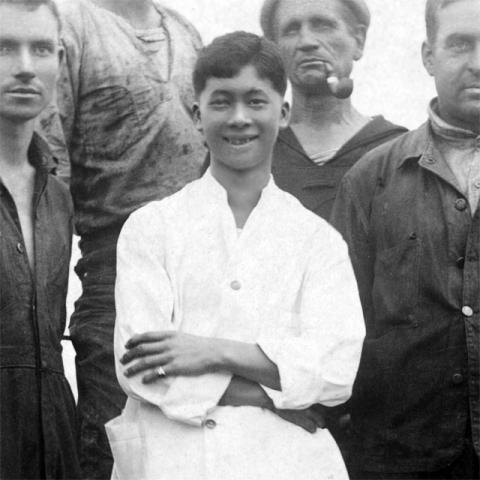
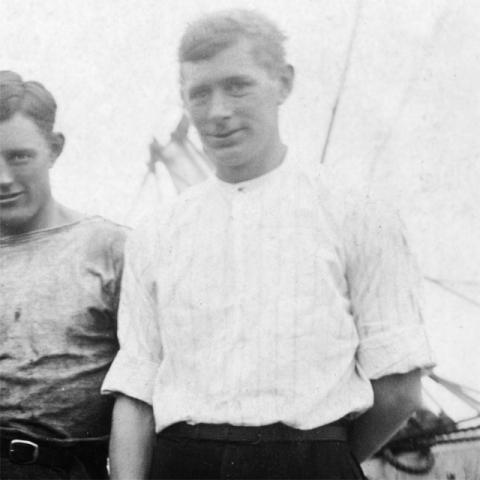
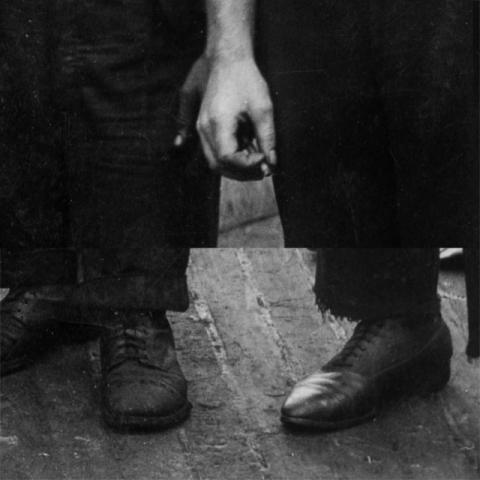
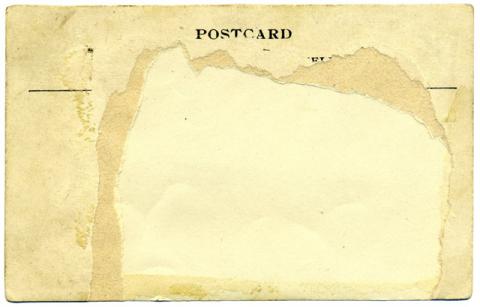
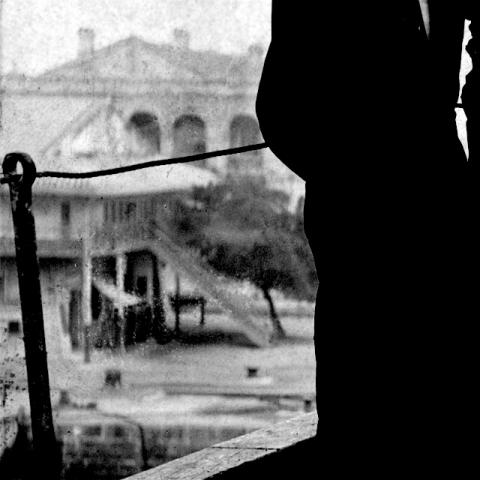

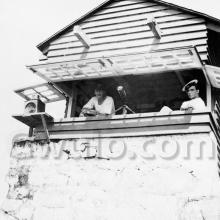
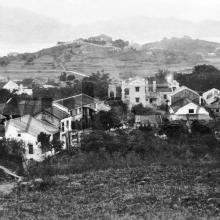
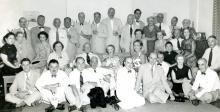
Comments
Re c.1910 Ship's crew at Hong Kong
Hi there,
It seemed to be a big ship (something like this) primarily made of wood. If you zoom in to the extreme and look at the lowert left corner, you should be able to see. That's a very big piece of wood there.
I also wonder if the piece of canvas was part of a sail.
Best Regards,
T
Re c.1910 Ship's crew at Hong Kong
Just my thoughts. If it is Kowloon Wharves, one would expect see to warehouses along the waterfront. So it could be somewhere else.
Chinese? Hong Kong?
Is the man in the white jacket really Chinese? And how sure are we it's Hong Kong?
The ship could have coal aboard without being coal-powered.
My great-grandfather was steward on one composite-built tea clipper out of London from about 1865 to 1878 (the 'Borealis'), which several times carried a 1300-ton cargo of coal from Sydney. Two destinations for the coal were Singapore and Shanghai. Coal - on a tea clipper. I ask you. Not too romantic. I worked aboard a coal-carrying rustbucket, Casablanca to Libya, in the 1960s. Ah, the sea air. Ah, the coal dust.
tea clipper
The narrow bow and the canvas indicates a tea clipper. The crew, I guess, is: US-American - Filipino. Two of them are lucky to have a spare white shirt. The one to the right even put his good shoes on for the foto. I think he has a cigarillo in his right hand, not a pencil. The shape of the smoking pipe looks like 1880 or later. I cant´t see a lot of coal traces. I think the men are of the last real sailors, not stokers.
It´s an impressive foto, because you seldom see the ordinary people who did all the work.
Crew at Hong Kong?
I am not so sure!
The bowsprit is there, but no jibboom, so she has not got enough headsails to be a sailing ship. Many steamships of this era were built with clipper bows and some head rigging, because "ships ought to look like that" - the straight bar stem looked "cheap" - and many of these steamers carried some limited sail plan "just in case".
The wooden bulwark rail is very striking, but two of the men are wearing regular blue boiler suits, and the dirty shoes might very well be engine room shoes - a habit kept up by marine engineers to this day. Certainly only the man on the right is "in his go ashores"!
I suspect that this is a steamer and this is a picture of the officers, including the cook. They look tired and maybe they have been hard at work but the cook has changed his jacket (compare with his trousers!) If the chap on the right is the Master he will have been doing paperwork whilst the others (engineers, mates, cook) have been at work on board. I wonder if the ship is perhaps in dry dock? That would explain the hard work in port.
I wonder if the location is Taikoo Docks?
Could I post this on the Ships Nostalgia website? There is a bunch of experts there...
Ship's crew
Thanks for all the comments. I've also had a couple of replies by email. One from Alan:
Looking at the deck planking and the curve of the bulwark, my first thought was that is was taken near the bow. The crew may still have been living in the foc’s’le in those days.
The smart chap may be an officer in his working rig – frayed uniform trousers and his stiff collar removed – but I think he is holding a cigarette. It is the traditional way of holding one when you want to keep it out of the breeze at sea (or when you do not want a senior officer to see you).
The canvas (untidy) might be a hatch tarpaulin which has been removed but not yet stowed neatly.
The young local lad might be a messboy. In the 1930s and 1940s the crew of naval vessels often recruited them while their ships were in HK. They were so cheap that even a junior ratings mess could afford one, and he would clean, do laundry etc. for a pittance – happy to have a job, plenty to eat and, probably, the chance to make a bit of money on the side. I do not know if merchant vessels had the same system, but it is a possible alternative explanation. The fact that this lad is wearing a proper messman’s jacket may indicate he was a member of the crew, of course. My father’s photograph of his temporary messboy on a warship in 1946 showed him in just a white singlet, and he was younger than the one in your photograph.
And one from Jerry:
If I might hazard a guess on this one. Judging from the height of the ship above the sea wall I would say that the ship is in dry-dock. Which would also explain the air of unhappiness about the crew, they have been deprived of shore leave to effect repairs on their vessel. Also, the man with the pencil is likely an employee of the dockyard and not a member of the ship's crew.
So let me take second run through my guesses:
Who: Ian asks "Is the man in the white jacket really Chinese?". He's obviously Asian, but I don't know for sure where he's from. Maybe Filipino, as Christoph suggests.
For the other man I mentioned, here's a close-up of the pencil / cigarette:
When: If it's a sailing ship, would that help date it? Is there any sharp cut-off date when steam completely replaced sail for ships to Hong Kong?
Britain only allowed picture postcards in 1894, so the photo isn't older than that.
Where: "how sure are we it's Hong Kong?" Here's how the bottom-left corner of the card looked originally, before I got busy with the Photoshop:
The local photographer had slipped in a rough title when printing the photo.
As Moddsey says, the background isn't a good match for views of the Kowloon Wharves. So maybe Jerry is right and the ship is in one of Hong Kong's dry-docks - but wouldn't that tend to make it lower than usual rather than higher?
What: Alan's right that I've got the ship back-to-front in my mind. Looking again there's the bowsprit behind the shoulder of the man with the polished shoes, so they're standing at the bow not the stern.
Any additional ideas welcome!
Regards,
David
re: Crew at Hong Kong?
Thanks Andrew, just saw your reply after I posted mine. Yes please to any help the experts at Ships Nostalgia can offer. Is it ok to give them a link to this page, or should I email you a copy of the image to post there?
Looking again at the bulwark, would they have been solid wood or planks? I can see lines that look like the edges of planks. Not sure what that would mean, if anything!
regards, David
Linked... I noticed that the
Linked...
I noticed that the wooden bulwark is unpainted. Odd. Might be a repair.
The Asian and the port
I think that the Asian man may be from Burma. The average daytime high in Rangoon in the coldest month (July) is about 28C. The crew (?) certainly don't look dressed for that climate. I had been thinking that the photo was being taken maybe for the white-coated man to take home and show his folks who his buddies were.
Also, Rangoon was a port of call on my gt-grandfather's clipper. His ship was often chartered by Jardine Matheson for between-ports cargoes Rangoon-Singapore-Saigon-Hong Kong-Shanghai-Yokohama. JM has archives of course.
Gold ring on the little finger - is that a cultural indicator at all?
comments from Ship's Nostalgia forum
The consensus is that the man in the white jacket is indeed Burmese.
comments from Ship's Nostalgia forum
The other comment is that the canvas on the deck has a bolt rope visible so it must be a sail, not a hatchcloth.
Re: Spelling of Hong Kong
The spelling of Hong Kong as two words only became official after 30 August 1926. This photo appears to have been taken at least 20 years earlier and before the change in spelling. I wonder whether or not the photo was taken in Hong Kong.
Spelling
Hong Kong with two words was pretty common throughout the 19th century, albeit unoficially - perhaps the most obvious case being the The Hong Kong Daily Press. Just as a point of interest, if memory serves, it was officially changed from Hong Kong to Hongkong in the mid 1840s.
regards, Adam
Ship's crew
Thanks for the extra information. The man being Burmese means there isn't any value in the absence of a queue - something I'd wondered about.
I think the 'Hong Kong' title is likely to be true. It looks like a photo that was taken by a local photographer, then sold back to the crew as a postcard, so it doesn't seem likely they'd get the location muddled up.
Still no positive ID on the background buildings though. Are these all the possibilities:
Taikoo / Cospmopolitan Docks?
Stephen Davies writes:
The ship looks to me as though it was either in Taikoo or Cosmopolitan Dock - and my hunch is the former. One reason for this is that Swire (in the guise of the Australian-Oriental Line) owned four sister ship cargo passenger liners, the Taiyuan, Changsha, Chingtu and Tsinan with bows quite like this one (clipper bows with bowsprit but no jibboom).
The better dressed bloke on the right is unquestionably holding a fag in the old way of the lit end reversed into the palm of the hand to shield it from the wind and prying eyes when sneaking an illegal smoko.